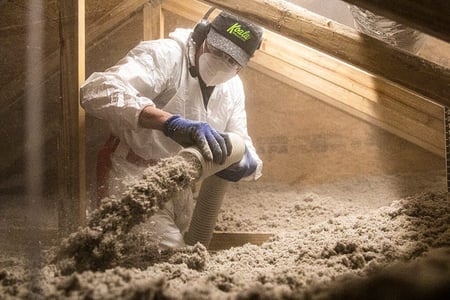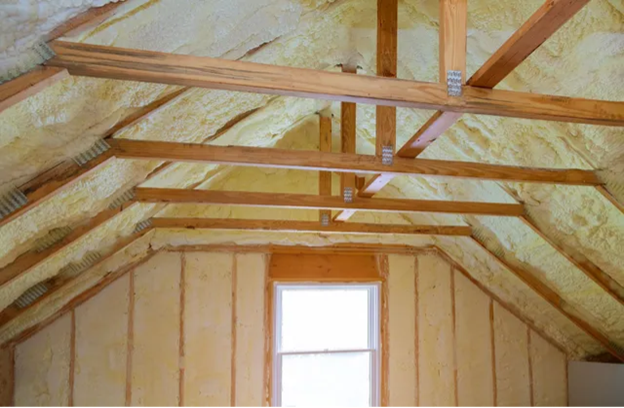
Cellulose insulation is a sustainable option for homeowners looking to improve energy efficiency and reduce noise from inside and outside their homes. Sometimes referred to as “recycled paper” insulation, cellulose is often misconstrued for older, potentially harmful types of insulation. Today’s products are widely considered not only safe but also one of the most cost-effective and eco-friendly insulation options on the market.
Learn more about the various types of cellulose insulation, how it compares to similar options like fiberglass, and why it may be an excellent fit for your home.
What Is Cellulose Insulation Made Of?
Cellulose insulation is thermal insulation made from recycled paper products. Composed of processed newspaper, office paper, and cardboard, cellulose is treated with chemicals to make it fire-retardant, pest-resistant, and mold-resistant.
What Does Cellulose Insulation Look Like?
Cellulose insulation looks like cotton fluff and is usually grey, tan, or beige. Since it is primarily made of shredded paper, it often resembles raw paper pulp. Old cellulose insulation might look dusty once it has settled or compressed.
There are two common types of cellulose products available, both of which are sometimes referred to by the blanket term “blown-in cellulose”.
- Loose fill: Cellulose insulation blown onto attic floors.
- Dense-pack: Cellulose insulation blown into enclosed walls or ceiling cavities to create an air-sealed layer.
The Pros and Cons of Cellulose Insulation
Cellulose is an excellent choice as a long-lasting attic insulation, but some drawbacks make it less than ideal in other applications.
Pros of Cellulose Insulation
- Eco-friendly: Cellulose is considered one of the most sustainable insulation materials since it is mostly made from recycled materials.
- High thermal resistance: The R-value of cellulose insulation is higher per inch than many other options, delivering exceptional thermal resistance with less material.
- Easy installation: Blown-in cellulose covers attics and tight spaces in ways other materials like rigid foam board and batt insulation can’t.
Cons of Cellulose Insulation
- Moisture sensitivity: Even treated cellulose insulation is more likely to absorb moisture than other materials, increasing the risk of water damage and mold growth.
- Settling: Cellulose tends to settle or compress over time, which limits its effectiveness by creating air pockets that transfer heat.
- Dust: While only a problem during installation, cellulose creates fine dust that requires careful mitigation and clean-up.
Cellulose Insulation Versus Fiberglass Insulation
Cellulose and fiberglass insulation, the two most common blown-in insulation options, share many similarities: Both work well in enclosed spaces and provide excellent thermal resistance in walls, ceilings, and attics. Cellulose has a higher R-value per square inch and tends to be more expensive, while fiberglass offers better moisture resistance.
Key Differences Between Blown-in Cellulose and Fiberglass Insulation
| Blown-in Cellulose | Blown-in Fiberglass | |
| Composition |
Up to 85% recycled paper, treated with chemicals. |
Spun glass fibers, primarily made from sand and recycled glass. |
| R-value per Inch |
R-3.2 to R-3.8 |
R-2.2 to R-2.7 |
| Air Sealing |
Dense-packed application blocks airflow effectively. |
Less dense, allowing more air to move through. |
| Fire Resistance |
Treated with borates to resist fire. In a fire, it chars and slows the spread of the flame. |
Naturally non-combustible; it melts at high temperatures. |
| Sound Dampening |
Excellent due to its high density. |
Good, but less effective than cellulose. |
| Settling |
Prone to settling over time, which can reduce its R-value if not initially overfilled. |
Less prone to settling, maintaining its thickness and R-value. |
| Environmental Impact |
Very eco-friendly with a high recycled content and low embodied energy. |
Contains recycled content but requires more energy to produce. |
Your local Koala Insulation contractor will recommend cellulose or fiberglass insulation based on your budget and the demands of your project.
How Long Does Cellulose Insulation Last?
Cellulose insulation will last 20 to 30 years or more with proper installation. Its effective lifespan declines if exposed to moisture, settling, or pest infestations. It’s a good idea to visually inspect insulation yourself annually and get a professional assessment at least every five years.
Is Cellulose Insulation Good for Soundproofing?
In addition to its stellar thermal resistance, cellulose effectively absorbs high-frequency noise from TVs, nearby conversations, and other non-impact sounds. It’s considered one of the top noise-dampening options available, along with mineral wool. Because cellulose costs less than mineral wool, it’s generally the more budget-friendly noise-reducing choice for most homeowners.
Is Cellulose Insulation Safe?
Cellulose is considered safe with proper installation and handling. The root of some health concerns around the product stems from the boric acid treatment that makes it pest-resistant and fire-retardant. Boric acid is a naturally occurring chemical also found in a range of consumer products, including eye drops. It is not toxic in humans in normal amounts and has not been linked to cancer or other health issues.
Other criticisms, such as cellulose insulation and mold growth or poor fire-resistance, aren’t supported by the evidence. Studies show treated cellulose offers increased protection against fire spread and pests than non-treated insulation.
Rest assured, the cellulose insulation in the walls and attics of millions of homes is safe and incredibly effective.
Find Cellulose Insulation Installation Near Me
As a leading cellulose insulation contractor, our local teams have the skill, training, and resources to enhance your home’s energy environment. Our cellulose insulation installation services are built around safety, convenience, and excellent customer support. Find the Koala Insulation location nearest you to schedule a free estimate today!
Find Your Location


Get a quote






